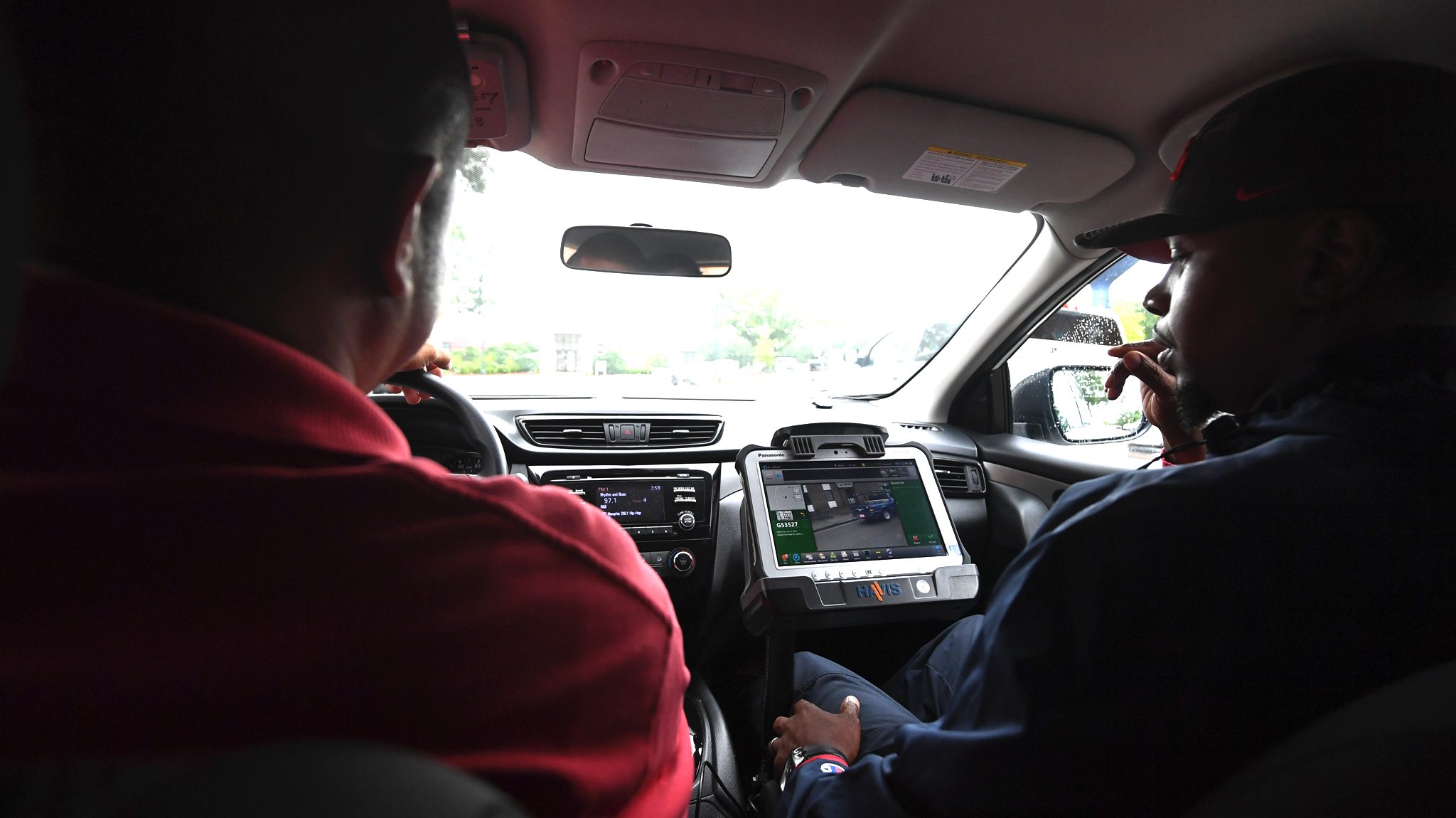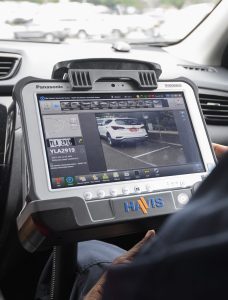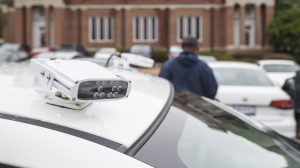
UM parking officers patrol campus lots using new automatic license plate reader technology. Photo by Thomas Graning/Ole Miss Digital Imaging Services
OXFORD, Miss. – The University of Mississippi Department of Parking and Transportation is testing a new automatic license plate recognition system that could improve efficiency, be more user-friendly and help keep parking permit costs as low as possible for the campus community.
The Auto Vu system, which has been employed by other universities across the country, uses cameras mounted on a compact SUV to scan license plates. Using software on a laptop inside the SUV, the license plates are checked against the database of registered vehicles, and if the car is not registered on campus for that particular parking zone, the driver is ticketed.
The program could remove the need for printed hangtags and decals, which could save the department an estimated $100,000 per year.
Testing began in March, and if the system continues to function well, it will be phased in over the next two to three years, said Mike Harris, UM director of parking and transportation.
“It’s working well right now,” Harris said. “We’re running the LPR system at the same time we’re still issuing permits. We want to give it some time to see how accurate it is and whether it is going to work.
“This is a trial period to see if this is where we want to go in the future. The goal is, however, to go to electronic permits. Then, your license plate would be your actual permit.”

The Auto Vu system scans license plates and uses software on a laptop inside the SUV to check them against a database of registered vehicles on campus. Photo by Thomas Graning/Ole Miss Digital Imaging Services
Parking permit sales for the 2019-20 academic year begin this month. Members of the campus community who have a parking permit and obtained a new license plate, should follow the Update License Plate Information link and submit the requested information. New vehicles can be added at the time of permit purchase.
The future implementation of a hangtag-free system will depend heavily on faculty, staff and students to update their tag numbers, Harris said. The interface on the Parking and Transportation website allows those with permits to update their registrations instantly if they get a new license plate or change vehicles.
Eventually, if the hangtag-free system is adopted, parking officials will move toward emailed citations, instead of having them placed on vehicle windows.
“We’re trying to make it a lot more seamless for the user, whether it’s a student, faculty or staff,” said Richard Bradley, manager of administrative affairs for parking and transportation. “Eventually, once we go to virtual permits, you will be able to update that information in real time. It’s a transition to a completely electronic process.”
Parking officials will allow drivers who want to back into their parking spaces to do so. They will not be ticketed, but it will require a parking worker to get out of the vehicle and walk behind the car to scan the plate in most cases, though some out-of-state drivers may have license plates on both the front and back.
“There is no rule that says you can’t park either way,” Harris said. “We’re going to keep it that way.
“Now, it does take away from our efficiency. I have to send a person out there on foot to handle the cars that are backed into a space. It does make our system a little less efficient.”
The software also will provide better reports on parking lot usage, which will help the department maximize the availability of parking where it’s needed most.
The system is in use at the University of Southern Mississippi, and other institutions in the state are transitioning to the same technology.
“The widespread adoption of this technology in the last two to three years, and also the amount of advancement of the technology and the cameras, has been incredible to watch,” Bradley said.

UM parking officer William Young writes a ticket while patrolling campus lots using new automatic license plate reader technology. The Auto Vu system uses cameras mounted on an SUV to scan license plates. Photo by Thomas Graning/Ole Miss Digital Imaging Services
For several years, the department has used carts to cover campus. The Auto Vu system uses cameras mounted on the sides of a Nissan Rogue SUV, and it is driven down the aisles of lots, scanning plates on both sides of it as it goes.
Next year, Parking and Transportation may opt to add a second vehicle to the process, which could reduce the number of traffic enforcement personnel needed. No jobs will be eliminated, but some jobs wouldn’t be filled when they become open, Harris said.
“Efficiency is a big thing,” he said. “Running a vehicle with license plate software is a much more efficient, faster way of doing things.
“We can cover campus with two vehicles, instead of 10 employees. The more efficient we are, the better we are.”
Parking enforcement jobs typically have a high turnover rate, but the virtual permit system would make it easier on those employees, who historically have spent their days out in the elements writing tickets.
A two-person team mans the SUV. One drives and the other watches a laptop, which has the parking software. It takes the LPR vehicle about an hour to cover all parking lots on campus.
When he started at Ole Miss five years ago, Emanuel McJunkins, a parking enforcement officer who drives the test vehicle, said he walked as much as 21 miles in a given workday.
“My calves looked like soda cans from all that walking,” McJunkins said with a laugh. “This new system is much better.”